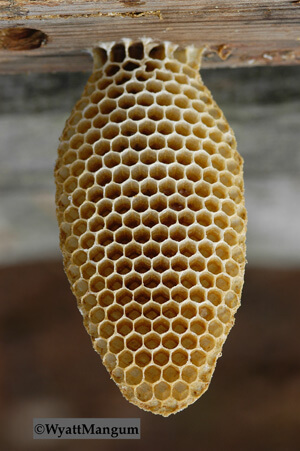
With the approach of spring, let’s examine some various aspects of comb construction, ending with an example of straight combs destroyed. My top-bar hives and frame hives will provide a wide selection of comb-building situations.
Sometimes comb construction records a nectar flow. In Figure 1, we see a small piece of burr comb. Figure 2 shows a cross section of the same comb. Notice the darker wax toward the middle of the comb. Along the outer edges of the comb, the wax is lighter in color. From the color differences, the bees might have started the comb in an earlier nectar flow, but they could not finish construction once the flow stopped. In the intervening time the wax darkened. Sometime later another nectar flow started, and the bees extended the cell walls with new white wax, giving rise to the color pattern in the cross section.
Another way this color pattern could occur is if the bees used some recycled (darker) wax to begin the comb. Bees can build comb in small amounts from recycled wax, just before the beginning of the spring nectar flow. Then once the spring flow began and wax production started, the bees switched to using the newly secreted white wax to finish lengthening the cells. With this last interpretation in mind, it is important to remember not to leave foundation on a colony when there is no nectar flow. The bees might chew up the edges of the foundation and presumably use it elsewhere in the hive.
Before the spring nectar flowers, I watch the bees use recycled wax to repair comb, to build burr comb, and to construct queen cell cups. Figure 3 shows a pair of queen cell cups bearing a change in the origin of wax. The bees made the left queen cell cup from recycled brown wax, as they typically do when the brood nest grows, but before an abundance of spring nectar. In more prosperous conditions, the queen cell cup on the right was built with an addition of new wax. Notice though, the pits at the base of the queen cell cup are brown, suggesting the bees built the newer addition upon an older queen cell cup base.
Now let’s assume an intense spring nectar flow has begun. Foundation is in the hive, and the bees are producing wax. The bees, following the hexagonal pattern embossed on the foundation, build the walls of the comb. The bees need a prominent edge to begin their work. That edge on the foundation, sometimes called a sidewall, runs along the hexagons. If the sidewalls are not distinct, the bees might be slow in building comb from the foundation, or they may never use the foundation. Figure 4 shows a close-up comparison between foundations with (upper) and without (lower) well-formed sidewalls. In addition, the impressions are generally a poor quality for the lower foundation.
Proceeding to the more extreme, giving the bees a blank (un-embossed) sheet of wax, not surprisingly, they just walk over it for days without any (normal) comb construction, even during a strong nectar flow. Since the wax sheets are easy to make and no expensive embossing is needed, beekeepers have tried giving bees blank wax sheets, but with little success. Instead of a full blank sheet, others have tried using just a blank strip of wax to get the bees to align combs straight in the frames. In this situation, the bees build the comb mainly from the lower edge of the strip, if they do it at all.
Figure 5 shows an example of comb construction under these conditions. Interestingly, if I make a few unconnected impressions in the blank strip with the head of a heated up small nail, forming little rims of circular impressions, similar to sidewalls in foundation, the bees will try to start building their cell walls (see Figure 6). That idea motivated the following:
Instead of giving the bees no pattern on the wax sheet, what if the wrong pattern was on the sheet? For example, what if I give the bees a sheet of wax with a pattern of small squares inscribed on it? (That is easy to make.) What will the bees do? Inscribing the pattern can form edges in the wax from which the bees can start their cell walls. But obviously the square shapes are wron


